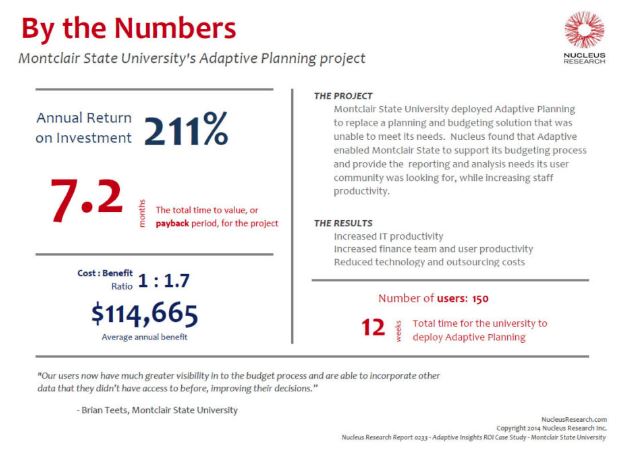Solving for the Top 3 Financial Planning Challenges in Higher Education
The process of creating a new fiscal year budget or long range plan, especially for Higher Education, tends to be overly complex, fraught with strategy misalignment and riddled with errors. I know this all too well as a former Budget Manager at Montclair State University, New Jersey’s second largest institution. Later, I became an implementer of a CPM solution and realized these challenges were pervasive with other institutions – it’s a systemic problem.
Institutions are facing increasing financial pressure from all angles. Some sources include decreasing support from state legislatures, material last-minute changes to the budget and plan, and requirements to limit growth in tuition and student fees. Simply put, institutions are being tasked to be more nimble and do more with less.
The budgeting process only adds to that pressure. Whether it’s a top-down, bottoms-up or hybrid approach, it typically requires several error-prone, manual steps such as emailing spreadsheets to dozens of people around the institution. In this case, school leaders or entities fill in their numbers (some adding lines for detail that break links) in a spreadsheet. The spreadsheet then needs to be consolidated. This requires more manual effort, no audit trail, no role-based access controls, and certainly, no single version of the truth. And budget management in costly and complex on-premise systems doesn’t fare much better.
However, with a modern CPM solution and the right budgeting processes, any institution can tackle the challenges being faced. The top three financial planning challenges in Higher Education are:
- Decentralized Decision Making
- Multi-Dimensional Planning and Reporting
- Personnel Planning
Take it from me, there is a light at the end of the tunnel. Montclair State University suffered from the same financial planning challenges that most other institutions are facing today. In the end, these three financial planning challenges were solved for through the deployment of a modern CPM solution and robust planning processes. There were also strong direct and indirect benefits that were captured in a ROI case study by Nucleus Research: a 211% ROI, an average annual benefit of $114K, and payback in 7.2 months. The planning cycle was also reduced and the project was deployed in 12 weeks.¹

“Adaptive Insights ROI Case Study: Montclair State University.” Nucleus Research | Return On Investment (ROI), Nucleus Research, Nov. 2014, nucleusresearch.com/research/single/adaptive-insights-roi-case-study-montclair-state-university/.
Decentralized Decision Making
How can you empower unit leaders to collaborate to help grow revenue and control costs?
It comes down to the tool and process. A modern CPM solution easily allows collaborators to participate in the same revenue and expense models and integrate their source ERP, Student, HR, and any other systems. The solution also allows for self-service dashboards and reports, empowering unit leaders to be more in tune with the financial outcomes of their unit.
Process is also very important. In the symphony of your budget, Finance should be the conductor of overseeing the strategy, while the Budget Managers play the part of the orchestra. This is where Finance should be central to the translation of that overall strategy via a well-facilitated planning process. Using a modern CPM solution, it will contain applications such as workflow for budget approval mechanisms and process tracker. These features contribute to stronger oversight and management of the planning process.
Encouraging collaboration in a more decentralized approach can lead to shorter planning times too. The key to minimizing feelings of discontentment when budgets get cut in executive review is having that strong process in place governed by Finance. This is one of the ways that I have solved for decentralized financial planning challenges in Higher Education.
This is not an all or nothing approach. Decentralized decision making is an option. It may still make sense to keep certain processes such as personnel planning or allocations in a central planning perspective.
Multi-Dimensional Planning & Reporting
It is difficult to plan and align data. The FOAPAL structure is multi-dimensional, which typically breaks down in Excel-based templates. There is also a relentless battle over disconnected reports between NACUBO and Management purposes that Excel, ERP systems, and on-premise tools aren’t effectively equipped to handle.
How can you minimize wasted effort in preparing reports and make more time for Analysis and scenario planning?

A modern CPM solution can solve for this by providing a means to do driver-based modeling, forecasts and bottoms-up plans, all leading to a more precise budget and long range plan and better use of the institution’s limited resources. The right tool contains mechanisms to tag activities with strategic categorization and workflow approval mechanism of budgets, supplemental requests, and budget transfers. Further, it gives the ability to obtain real-time performance data back to the users so they can drill into any categorization, whether that be funds, account, projects, programs, and more.
Personnel Planning
It is extremely difficult to track the fully loaded costs of an employee and track vacant position savings. There are also challenges in securing who sees this data. Because of this, personnel planning tends to be disconnected from the other expense side of planning. It is also because of these challenges that an institution may be less likely to perform more accurate bottoms-up budgets or forecasts.
How can you more effectively manage your biggest expense – Personnel – with more confidence and control?
A modern CPM solution allows the granular row-based salary and benefit details. Behind these personnel plans lies a set of assumptions, updated in one place. These salary and benefit calculations are then seamlessly integrated into the financial statements. Handling complex personnel calculations, from union step increases to medical benefit expense calculations are a breeze in a modern CPM solution. While double entry of data works for accountants, it’s not the basis of a successful FP&A process.

These all may sound like great ideas to modernize process along with tool, but how painful is the process of transformation?
In my experience, the process of transformation does not have to be painful, lengthy or exorbitantly expensive.
You don’t have to do it all at once. Look to break the project into phases, then crawl, walk, and run. While single-event or ‘big bang’ go-live strategies are often required for ERP systems, this is not the case with a modern CPM solution. The success of an analytic solution implementation is directly tied to adoption.
Take some upfront time in design, planning and business requirements. Build more models as you progress on your FP&A journey. And keep key stakeholders engaged in design where applicable. For example, dashboards, which will help with change management and getting the buy-in and use of the new CPM solution.
At Montclair State, the transformation also went beyond ROI benefits; it was personal.
When a new Budget Manager in the College of Education was hired, he told me he was dreading having to learn our new CPM tool because he had used a complex on-premise solution before. However, he was trained and up in running in one hour. Later that week, he presented a financial analysis package to the Dean from the system. She remarked, “this must have taken you hours,” when in reality it only took minutes for him to prepare the reporting package. This is one of the many stories about how users became more efficient in their roles and shortened planning times.
Conclusion
The economic climate in Higher Education continues to change dramatically. Having a modern CPM solution and strong processes are an effective means to allow institutions to have greater control of their financial outcomes and solve for financial planning challenges in Higher Education. Now is the time to transform and begin to more effectively manage operational and administrative costs and be better equipped to manage the tides of change.
Resources
1 “Adaptive Insights ROI Case Study: Montclair State University.” Nucleus Research | Return On Investment (ROI), Nucleus Research, Nov. 2014, nucleusresearch.com/research/single/adaptive-insights-roi-case-study-montclair-state-university/.
About Ironside
Ironside was founded in 1999 as an enterprise data and analytics solution provider and system integrator. Our clients hire us to acquire, enrich and measure their data so they can make smarter, better decisions about their business. No matter your industry or specific business challenges, Ironside has the experience, perspective and agility to help transform your analytic environment.







